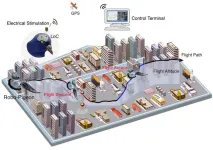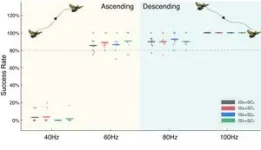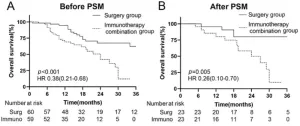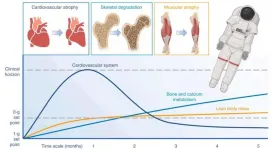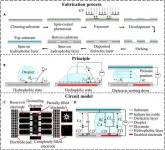(Press-News.org)
Background
Robo-pigeon / Cyborg pigeon is a new type of hybrid intelligent robotic system developed by combining micro-implantable brain-computer interface (BCI) and micro-electro-mechanical system (MEMS) technologies. By integrating the perception, motion and autonomous intelligence of real pigeons with the high precision, repeatability and controllability of MEMS, a flexible and efficient "biological flight platform" is formed, which has a broad application prospect in key fields such as disaster rescue, national defense security and environmental monitoring.
However, the precise and reliable control of the flight behavior of pigeon robots in the outdoor environment is still a difficult challenge, especially the control of flight altitude. The flight altitude not only directly affects the navigation ability of pigeon robots in complex three-dimensional space, but also is closely related to their adaptability, stability, and success rate of mission execution in dynamic environments. Therefore, realizing the precise control of the flight altitude of pigeon robots is the core of animal robots to go out of the laboratory and work in outdoor environments.
Research Progress
In order to solve the difficult problem of pigeon robots in outdoor flight altitude control, Prof. Zhendong Dai's team at the School of Electromechanics, Nanjing University of Aeronautics and Astronautics (NUAA), has started an in-depth cooperation with the Brain-Computer Interface and Fusion Intelligence team at the Institute of Automation, Chinese Academy of Sciences (CASIA). For the first time, the research team has expanded the research on flight control of pigeon robots from indoor to outdoor real flight environments, and proposed a quantitative neural stimulation method based on the Locus Coeruleus (LoC) of pigeon midbrain; the research team systematically explored the effects of three key parameters, namely stimulation frequency (SF), stimulation interval (ISI), and stimulation cycle (SC) on the flight altitude control of pigeon robots. (Fig. 1)
Results indicated that stimulation frequency (SF) functions as a critical "switch" determining the pigeon's flight mode (ascending or descending). At 60 Hz SF, pigeons exhibited an average ascent of 12.241 meters with an effectiveness rate of 87.72%, whereas at 80 Hz SF, they displayed an average descent of 15.655 meters with an effectiveness rate of 90.52% (Fig. 2). In contrast, frequencies below 40 Hz had minimal impact on altitude, while frequencies above 100 Hz tended to destabilize flight. Furthermore, the study revealed that increasing the number of stimulation cycles (SC) directly amplified altitude adjustments, allowing for quantifiable and controlled altitude changes. Although the inter-stimulus interval (ISI) had a less direct impact on altitude, it significantly affected flight velocity and neural fatigue levels (Fig. 3). Properly extending the ISI effectively reduced neural fatigue, optimizing the balance between response sensitivity and flight stability. Notably, stimulation of the LoC nucleus did not significantly alter flight direction, enabling pigeons to maintain their original heading during altitude changes, thus offering a viable method for independently controlling altitude without disrupting horizontal navigation.
This study is the first to clearly demonstrate the potential of targeted electrical stimulation of the LoC nucleus for precise altitude control in cyborg pigeons, establishing foundational theories and technical approaches for controlled animal flight operations.
Future Prospects
In the foreseeable future, cyborg pigeon technology holds promising opportunities across diverse fields. Equipped with cameras and sensors, these pigeons could perform search and rescue operations by exploiting their agility and autonomous obstacle-avoidance capabilities in hazardous terrains or disaster sites. For environmental monitoring and urban inspections, they can undertake prolonged flights and collect multi-dimensional data in real-time, thus enhancing environmental information networks. In defense and security applications, their inconspicuous appearance and adaptive flying capabilities are advantageous for front-line reconnaissance and communication relay missions in high-risk environments.
Most importantly, the brain-computer interface and closed-loop control methods developed through cyborg pigeons offer significant inspiration for designing semi-biological drones or advanced bio-inspired flying machines. By deepening our understanding of neural control mechanisms in flying animals, we can refine flight control algorithms and simultaneously gain deeper insights into avian physiology and neuroscience. With continuous technological advancements, cyborg pigeons are poised to expand their practical roles, becoming innovative platforms that integrate biological and engineering systems.
END
Whether it’s for your vehicle or your home, from small-scale uses to the largest, the debate over the most efficient and cost-effective fuels continues. Currently, there’s no shortage of options either.
Nuclear power provides an alternative to more conventional energy options but requires rigorous systems monitoring and safety procedures. Machine learning could make keeping a close eye on key elements of nuclear systems easier and response time to issues faster.
Syed Bahauddin Alam, an assistant professor ...
Hepatocellular carcinoma (HCC) is a leading cause of cancer-related deaths worldwide, with over 70% of patients diagnosed at an advanced stage due to the absence of symptoms. A key characteristic of advanced HCC is extrahepatic metastasis, particularly pulmonary metastasis, which is associated with a poor prognosis.
Although multitargeted tyrosine kinase inhibitors (TKIs) and immune checkpoint inhibitors have limited efficacy when used alone in advanced HCC, their combination can enhance outcomes for patients with pulmonary metastases. Meanwhile, pulmonary metastasectomy ...
A review published recently in Wearable Electronics examines the current applications and persistent challenges of flexible wearable technologies in aerospace medicine. As human space exploration progresses toward extended-duration missions, the imperative for real-time monitoring of astronauts' physiological and psychological well-being has become increasingly critical. The unique space environment characterized by microgravity conditions, cumulative radiation exposure, and extreme thermal fluctuations presents multifaceted health risks to crew members.
Flexible wearable systems, equipped ...
Complications during pregnancy (or adverse pregnancy outcomes), like gestational diabetes and newly developed high blood pressure, act as nature’s stress test and may uncover an individual’s risk for heart disease later in life, according to new research published in the JACC, the flagship journal of the American College of Cardiology. The study also highlights how weight management before pregnancy may not only improve maternal health but also reduce future cardiovascular disease risk.
The observational study, which ...
Cardiovascular disease is by far the most common cause of death worldwide, and myocardial infarction is the most common acute event. For those who survive a myocardial infarction, the risk of a new heart attack is greatest in the first year after the initial event because the blood vessels are more sensitive, making it easier for blood clots to develop. Reducing the “bad” cholesterol in the blood stabilises changes in the vessels, decreasing the risk for new events. The current established routine treatment is to treat with high-potency statins, immediately after the infarction. However, the majority ...
LUND UNIVERSITY/IMPERIAL COLLEGE LONDON PRESS RELEASE
[Peer-reviewed /Simulation/Modelling / People]
UNDER EMBARGO UNTIL:
Monday 14th April 2025
10:00 am US Eastern Time / 3:00 pm UK Time
Combination of drugs could prevent thousands of heart attacks
Patients who receive an add-on medication soon after a heart attack have a significantly better prognosis than those who receive it later, or not all.
This is according to a new study from researchers at Lund University in Sweden and Imperial College London. ...
New tool for cutting DNA: promising prospects for biotechnology
An INRS team discovers a new family of enzymes capable of inducing targeted cuts in single-stranded DNA
A few years ago, the advent of technology known as CRISPR was a major breakthrough in the scientific world. Developed from a derivative of the immune system of bacteria, CRISPR enables double strands of nucleotides in deoxyribonucleic acid (DNA) to be cut. This makes it possible to specifically modify a targeted gene in plant, animal and human cells. Ultimately, CRISPR became a preferred method in the search for treatments for acquired or hereditary diseases.
Recently, ...
Victoria, BC— For the first time, footprints of armoured dinosaurs with tail clubs have been identified, following discoveries made in the Canadian Rockies. The 100-million-year-old fossilized footprints were found at sites at both Tumbler Ridge, BC, and northwestern Alberta.
There are two main groups of ankylosaurs. Nodosaurid ankylosaurs have a flexible tail and four toes, while ankylosaurid ankylosaurs have a sledgehammer-like tail club, and only three toes on their feet.
Unlike the well-known ankylosaur footprints called Tetrapodosaurus ...
A research paper by scientists at Beijing Institute of Technology and City University of Hong Kong presented a versatile electrodynamics simulation model designed to analyze the driving forces of partially filled electrodes to optimize the structural parameters of Digital microfluidic chips.
The research paper, published on Mar. 06, 2025 in the journal Cyborg and Bionic Systems, utilizes finite element analysis to determine the voltage distribution within the Digital microfluidic chip and calculates the driving force acting on the droplets using the principles of virtual work.
Digital microfluidic chips (DMCs) have shown huge potential for biochemical analysis ...
COLUMBUS, Ohio – Insomnia and hazardous drinking are so closely intertwined that estimates suggest at least one-third, and as many as 91%, of people who have a hard time with sleep also misuse alcohol.
A new study suggests that perceived stress and depression factor into the relationship between the two conditions – perhaps not a surprise. But because the relationship between insomnia and heavy drinking goes in both directions, the influence of stress or depression depends on which condition came first, the analysis found.
“We were most interested in how insomnia leads to drinking, and we found that seems to occur primarily through ...
